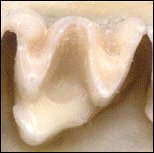The elephant shrews often have been placed in the order Insectivora and also have been associated with the Afrosoricida. The currently are placed as the sole family of the Macroscelidea.
There are four living genera with 15 species, all but one species (limited to North Africa) in central and eastern Africa. A long, flexible snout is responsible for the common name, while the scientific name refers to "long limbs," with the hind limbs longer than the forelimbs. A bipedal, kangaroo-like gait is used during rapid locomotion.
(limited to North Africa) in central and eastern Africa. A long, flexible snout is responsible for the common name, while the scientific name refers to "long limbs," with the hind limbs longer than the forelimbs. A bipedal, kangaroo-like gait is used during rapid locomotion.
The morphology differs from the true Soricomorpha in several ways, including presence of auditory bullae. A zygomatic arch is present and the teeth are dilambdodont (that is, they have a "w"-shaped ridge on the occlusal surface of the upper molars, such as in shrews and some bats). A cecum (a diverticulum of the intestinal tract at the junction of the small and large intestines) is present. The olfactory lobes of the brain are relatively small in contrast to soricomorphs. There are a number of openings in the hard palate.
Pictures of various species and of skulls are available at the Animal Diversity Web, University of Michigan Museum of Zoology.
Fig. 1. A dilambdodont molar of a mole. Unlike the situation in moles, however, elephant shrews have the upper molars squared up with four major cusps.
Last update: 19 Jan 2008
Centennial Museum and Department of Biological Sciences, The University of Texas at El Paso